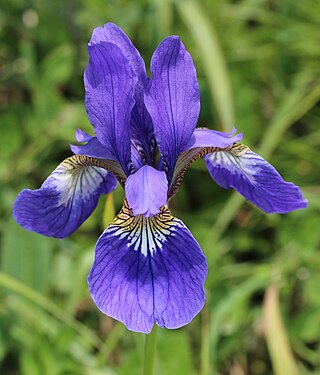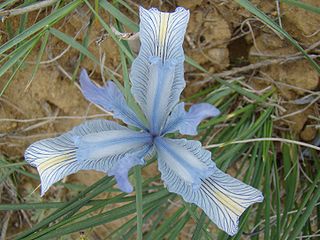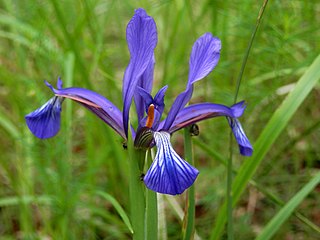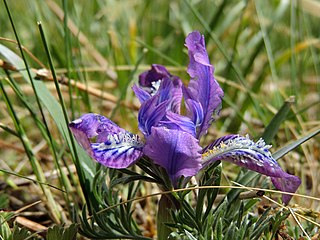
Iris japonica, commonly known as fringed iris, shaga and butterfly flower, is a native of China and Japan. It is a species in the genus Iris, in the subgenus Limniris and within the Lophiris section. It is a rhizomatous perennial plant, with pale blue, lavender or white flowers with an orange or yellow crest. It is cultivated as an ornamental plant in temperate regions.

Iris sanguinea is a rhizomatous flowering plant in the genus Iris and in the series Sibiricae. It is cultivated as an ornamental plant in temperate regions. It is one of the species considered a Japanese iris. It is from Asia, found between Russia, Mongolia, China, Japan and Korea. It has grey green leaves, an unbranched flowering stem and flowers in reddish-purple shades, from blue to blue-purple, red-violet, with a rare white variant.

Iris lactea is a species in the genus Iris. It is also in the subgenus Limniris and is the only species in the series Ensatae. The Japanese water iris, Iris ensata, is actually in series Laevigatae. It is a rhizomatous perennial, from central Asia, with pale blue or violet flowers. It is cultivated as an ornamental plant in temperate regions.

Iris ruthenica, sometimes called ever blooming iris, Russian iris, pilgrim iris and Hungarian iris, is a species in the genus Iris- subgenus Limniris. It is a rhizomatous perennial, with a wide distribution, ranging from eastern Europe to Central Asia. It has grass-like leaves, thick stem and violet or bluish lavender flowers which are marked with violet veining.

Iris setosa, the bristle-pointed iris, is a species of flowering plant in the genus Iris of the family Iridaceae, it belongs the subgenus Limniris and the series Tripetalae. It is a rhizomatous perennial from a wide range across the Arctic sea, including Alaska, Maine, Canada, Russia, northeastern Asia, China, Korea and southwards to Japan. The plant has tall branching stems, mid green leaves and violet, purple-blue, violet-blue, blue, to lavender flowers. There are also plants with pink and white flowers.

Iris tenuifolia is a beardless iris in the genus Iris, in the subgenus Limniris and in the series Tenuifoliae of the genus. It is a rhizomatous herbaceous perennial, from a wide region over central Asia, including Afghanistan, Pakistan, ; Kazakhstan, Uzbekistan and Mongolia and in China. It has long greyish-green leaves, short stem and pale violet, lilac, pale blue, or purple flowers.
Iris ventricosa is a beardless iris in the genus Iris, in the subgenus Limniris and in the series Tenuifoliae of the genus. It is a rhizomatous herbaceous perennial, from Asia and the Russian Federation, to Mongolia and China. It has grey-green leaves, short flowers stems and 1–2 pale violet or pale blue flowers.

Iris halophila is a species in the genus Iris. It is also in the subgenus Limniris and in series Spuriae. It is a rhizomatous perennial plant, with yellow, white or violet flowers. It is cultivated as an ornamental plant in temperate regions. It comes from a wide range from eastern Europe to China in Asia. It was known for a long while as a subspecies of Iris spuria, before being treated as a separate species in its own right.
Iris ludwigii, with the common name Ludwig iris, is a species in the genus Iris. It is also in the subgenus Iris subg. Limniris and in the series Spuriae. It is a rhizomatous perennial plant with violet-blue flowers. It is native to the Altai Mountains in Central Asia, where Russia, China, Mongolia, and Kazakhstan meet. It is cultivated as an ornamental plant in temperate regions.
Iris halophila var. sogdiana is a species in the genus Iris, subgenus Limniris and series Spuriae. It is a variety of Iris halophila. It was once a species in its own right as Iris sogdiana, before being re-classified as a synonym of Iris halophila, but it has been re-classed again as a variant of Iris halophila. It is a rhizomatous perennial plant, with blue-violet flowers. It is cultivated as an ornamental plant in temperate regions.

Iris pontica is a species in the genus Iris, it is also in the subgenus Limniris and in series Spuriae. It is a dwarf rhizomatous perennial plant from eastern Europe, the Causcasus region and Russia, with a short stem and violet-blue and white flowers. It is cultivated as an ornamental plant in temperate regions.

Iris sintenisii is a species in the genus Iris, in the subgenus Limniris and in series Spuriae, with tall thin stems, violet-blue flowers and long grass-like leaves. It is a rhizomatous perennial plant, from grass meadows parts of Europe, Russia, and Turkey. It is cultivated as an ornamental plant in temperate regions.
Iris bloudowii is a species in the genus Iris. It is also in the subgenus of Iris and in the Psammiris section. It is a rhizomatous perennial, from Russia, Siberia, Kazakhstan, Mongolia and China, with sickle-shaped leaves, slender stem and 2 bright or pale yellow flowers. It is cultivated as an ornamental plant in temperate regions.

Iris humilis is a plant species in the genus Iris. It is also in the subgenus of Iris and in the Psammiris section. It is a rhizomatous perennial, with a wide distribution range from Europe to Russia to China, via Mongolia and Kazakhstan. It has sword-shaped leaves, a short stem and yellow flowers with an orange beard. It is cultivated as an ornamental plant in temperate regions.
Iris mandshurica is a species in the genus Iris; it is also in the subgenus of Iris and in the Psammiris section. It is a rhizomatous perennial, it is found in Russia, China, and Korea. It has green sword-like leaves, smooth green stem and yellow flowers, with yellow-purple veining and a yellow beard. It is cultivated as an ornamental plant in temperate regions.
Iris ivanovae is a plant species in the genus Iris and part of the subgenus Iris and in the section Pseudoregelia. It is a rhizomatous perennial, from eastern Russia, China, and Mongolia.

Iris tigridia is a plant species in the genus Iris; it is also in the subgenus Iris and in the section Pseudoregelia. It is a rhizomatous perennial, from Kazakhstan, Russia, Mongolia and China. It has dark green or greyish green, grass-like leaves, a short slender stem and a single flowers that are either violet, dark blue, blue-purple, dark purple, mauve, lilac, lavender, or light purple. It is cultivated as an ornamental plant in temperate regions.

Iris glaucescens is a plant species in the genus Iris and subgenus Iris. It is a rhizomatous perennial, found in Russia, Kazakhstan, Mongolia and China. It has blue-grey sickle-shaped leaves, slender stem, and spring flowers in blue-violet, pale violet, lilac-purple, to deep purple, to light bluish, and almost white shades. It is rarely cultivated as an ornamental plant in temperate regions. It was merged with another similar iris in the region, and became a synonym of Iris scariosa, before being divided into two separate species again, although some sources still call it a synonym of Iris scariosa.

Iris scariosa is a plant species in the genus Iris; it is also in the subgenus Iris. It is a rhizomatous perennial from the mountainsides of Russia, Kazakhstan, Mongolia and China. It has sword-like, or sickle shaped, blue green or grey-green leaves, a short flowering stem, 3 or 4 membranous or semi-transparent flower bud leaves, 2 violet, reddish violet, lilac, blue-purple, or blue flowers in late spring, with yellow or white beards. It is cultivated as an ornamental plant in temperate regions. It was merged with another similar iris in the region, and Iris glaucescens became a synonym of Iris scariosa, before being divided into two separate species again. Although some sources still call it the main species, despite a slight colour difference.
Iris timofejewii is a species of flowering plant in the genus Iris, and also in the subgenus Iris. It is a rhizomatous perennial, from the mountain slopes of the Caucasus and Dagestan. It has narrow, evergreen, falcate (sickle-shaped), grey-green (glaucous) leaves, and a short flowering stem just taller than the leaves. Each stem has 1–2 flowers in shades of violet, with white beards that have purple tips. It is cultivated as an ornamental plant in temperate regions.














